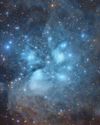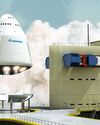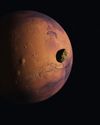
The seventh planet from the Sun, Uranus became the first planet to be found with the aid of a telescope on 13 March 1781 by British astronomer William Herschel. On that fateful night, he described observing a "nebulous star or perhaps a comet". Little did he know that he had just discovered Uranus, which was named after the Greek god of the sky - a name proposed by Johann Elert Bode in 1783.
240 years later, Uranus remains a puzzle. What is known is that Uranus is located about 2.9 billion kilometres (1.8 billion miles) from the Sun, about 19 times the distance from Earth to the star, meaning that one orbit of the Sun takes 84 Earth years. The planet is enormous, with a diameter of 50,724 kilometres (31,518 miles) - four times wider than Earth. Uranus has a compositional mass that is 80 per cent a fluid mixture of water, ammonia (NH,) and methane (CH,) ices. It's the methane in the outer atmosphere that gives it its blue-green colour, but the thick cloud coverage does not allow our instruments to peer down any further, and is one reason why Uranus remains an enigma.
Astronomers strongly suggest that below the planet's cloud tops is a main atmosphere which contains mostly hydrogen and helium by composition and has traces of methane and other volatiles. Below that is the fluid icy mantle, which makes up most of its composition by mass, but it's also theorised that the pressure and temperatures here are enough to make it “rain' diamonds at that depth. Finally, at the centre is the silicate iron-nickel core, thought to be between half to just over three times the mass of Earth.
Bu hikaye All About Space dergisinin Issue 128 sayısından alınmıştır.
Start your 7-day Magzter GOLD free trial to access thousands of curated premium stories, and 9,000+ magazines and newspapers.
Already a subscriber ? Giriş Yap
Bu hikaye All About Space dergisinin Issue 128 sayısından alınmıştır.
Start your 7-day Magzter GOLD free trial to access thousands of curated premium stories, and 9,000+ magazines and newspapers.
Already a subscriber? Giriş Yap

MYSTERIES OF THE UNI WHERE ARE ALL THE SPIRAL GALAXIES?
There are far fewer spiral galaxies than elliptical ones in the Supergalactic Plane, and scientists are keen to discover why

ZOMBIE STARS
+10 OTHER TERRIFYING SPACE OBJECTS

HOW TO BEAT LIGHT POLLUTION
Thought it was impossible to observe the wonders of the night sky from towns and cities? Think again. Follow our tips and tricks on successfully observing through sky glow

15 STUNNING STAR CLUSTERS
These beautiful stellar groupings are spattered across the cosmos

Eileen Collins "It was a difficult mission...we were the first to see Mir"
Having served as both the first female pilot and first female commander of NASA's Space Shuttle, Collins boosted the involvement of women in space exploration to a whole new level

MARS LEAKS FASTER WHEN IT'S CLOSER TO THE SUN
The Red Planet has lost enough water to space to form a global ocean hundreds of kilometres deep

FUTURE TECH KANKOH-MARU
This ambitious reusable spacecraft will be capable of taking 50 people to and from orbit

THE FINAL FRONTIER
Beyond the reach of the Sun is a fascinating region of the cosmos that were only just beginning to explore

A long-lost moon could explain Mars' weird shape and extreme terrain
A long-lost moon could explain why Mars is so different from the other rocky planets in the Solar System. Today Mars has two tiny moons.

A sprinkling of cosmic dust may have helped kick-start life on Earth
Cosmic dust may have helped kick-start life on Earth. New findings challenge a widely held assumption that this wasn't a plausible explanation.